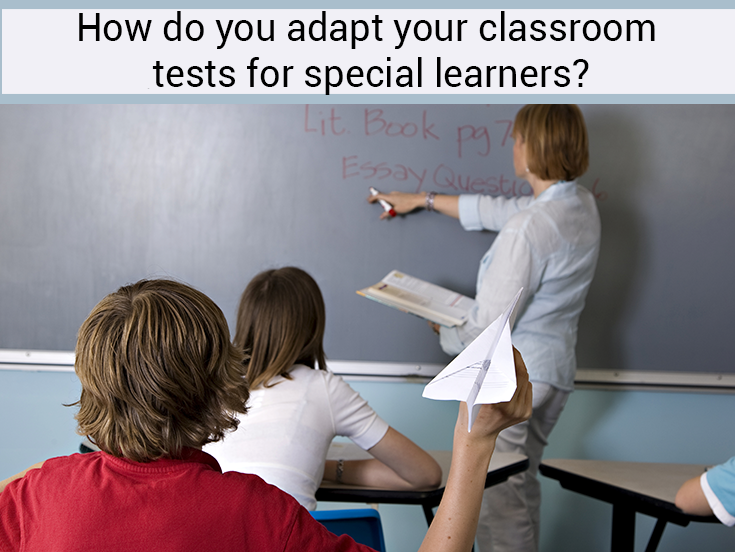How Can Teachers Adapt Classroom Tests For Students With ADHD?
Posted by Network Support · Leave a Comment
Test modifications can be a lifesaver for many students with ADHD
Attention Deficit Hyperactivity disorder or ADHD is seen commonly in today’s classrooms. Children with this condition may be restless, find it difficult to sit, and may be impulsive and have a very short attention span. On the other hand, they are also very intelligent and creative.
These energetic students can often disrupt a classroom. Thus, it becomes more important for teachers to understand what this condition is all about and learn strategies to teach a child with ADHD.
Among other strategies to deal with ADHD, testing is an important aspect of educating a child with ADHD. This is because if the child is unable to perform on tests, they will have difficulty moving forward in their education. A lot of children with ADHD will “know” things, but will not be able to perform well on tests. Following are some options that are available to assist and support such students.
By understanding the purpose of evaluations, accommodations can be more easily put into place. For example, use of a calculator for a math exam that is dealing with problem solving may not be considered giving unfair advantage to the student with ADHD.
1. Aids
Adaptations and aids that can be used for testing can be divided into two categories – Low Tech and High Tech.
Low Tech:
- Colored erasers can assist a student in easily spotting their intended corrections
- Sharpened pencils prevent students from losing time from by needing to sharpen their pencil mid-way through the test
- Special paper, graph paper, or a writing template can enable a student to maintain an improved physical posture for focused attention and writing test
- Markers or visual stickers might be used to highlight the questions or words to which a student needs to pay special attention
- Place keepers, trackers and pointers enable students to keep their place. This can also be accomplished through the assistance of a proctor who non-verbally assists in the manual tracking from item to item or item to answer sheet.
High Tech Aids:
- Adaptive keyboard, word processor, voice-activated word processor, or voice synthesizer etc might be used to help the student dictate their answers to a test. This helps students with ADHD to concentrate on the answers rather than the process of answering
- Students whose disability impacts their ability to either memorize or compute basic math facts might be permitted to use computational aids
2. Timing
Extended time might be given to complete tests. Determination should be made as to whether the student can successfully sustain the activity time owing to physical disability or limited attention span. Additional sessions may be arranged as needed to schedule testing completion.
The schedule and timings may be multiple testing sessions of short duration, followed by periodic rest breaks.
Students with ADHD often need more time for tests. Sometimes timed tests are reduced in number or eliminated altogether. Some individualized student plans permit a student to take more time on a test. Ideally, to make the accommodation implementation successful, this is done in a separate location because students with ADHD will often rush when they perceive that others are finishing. While planning a test for a student with ADHD, care should be given to the seating arrangement. If possible, providing multiple choice questions may be ideal as these do not require comprehensive responses. Of course, this is not always plausible and it’s essential that students demonstrate their understanding or lack thereof.
3. Format
In some situations, the format of the test may need to be changed to accommodate a child with ADHD. And, under some circumstances, accommodations may be limited. Discuss adaptations with the special educator and the rest of the team while ensuring alignment of the student’s individualized plan.
The test might be given by a person familiar to the child. Test items and directions may be read aloud by the test administrator at the start of the exam. Instructions may be paraphrased in a simplified language. Keywords in directions can be underlined or highlighted. Students may be given a written copy of examiner’s instruction at the time of the tests.
Arrangements may be made for the students to mark answers in test booklets or with the help of machines. It is always easier to write the answers on large spaced paper (use light colored papers, that are anti-glare) or with the help of an assistant who records the answer. The student might answer to scribe or tape recorder. For a writing assessment, they might include specific instruction about punctuation.
For the student who needs help tracking the questions and their responses, someone might help by pointing or placing the student’s finger on the items. If possible, fewer items might be placed on each page and cues such as arrows and stop signs provided on the answer form.
4. Scribe
In general, the student who uses a scribe to aid in recording responses must provide all information, including spelling of difficult words, punctuation, paragraphing, grammar, etc. When taking the help of scribe the students should know the scribe’s identity ahead of time and the scribe should have previous experience working in such a capacity with students.
Like this article for teachers?
Browse the Professional Learning Board COURSE CATALOG to find related online courses for teachers in your state. Professional Learning Board is a leading provider of online professional development classes that teachers use to renew a teaching license or renew a teaching certificate.





